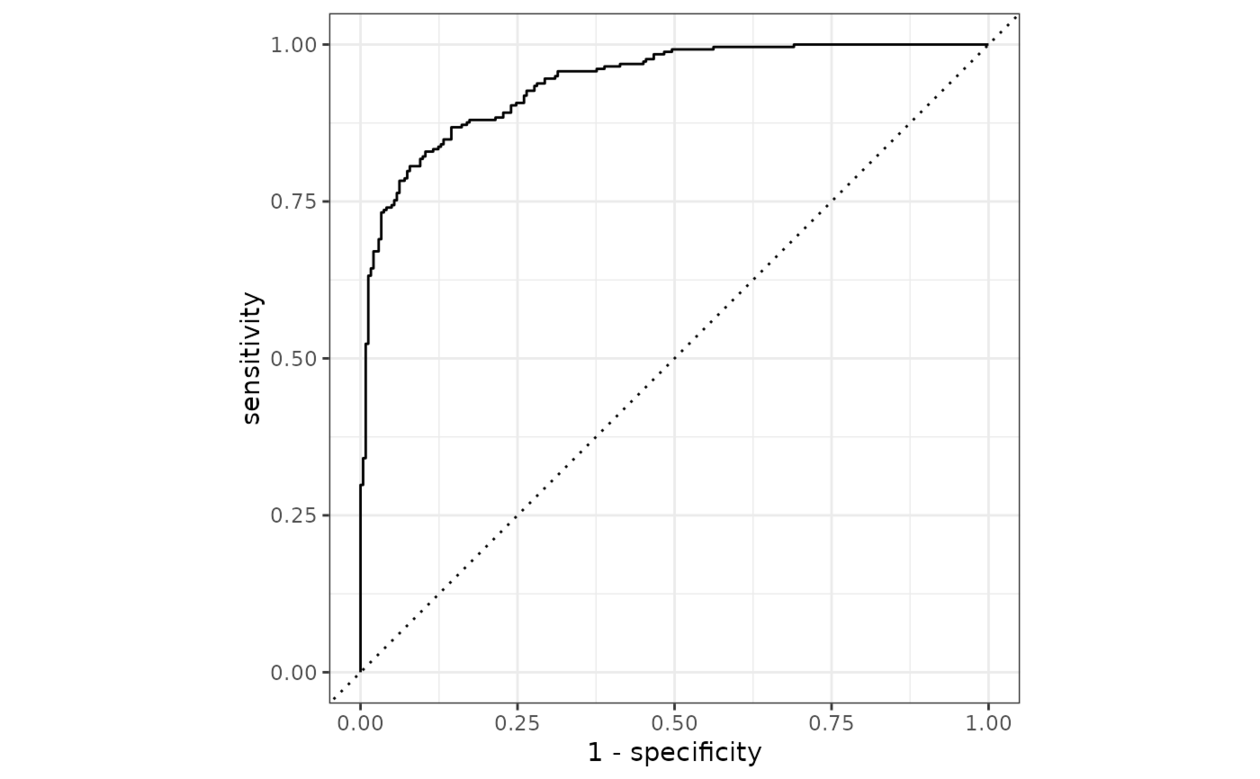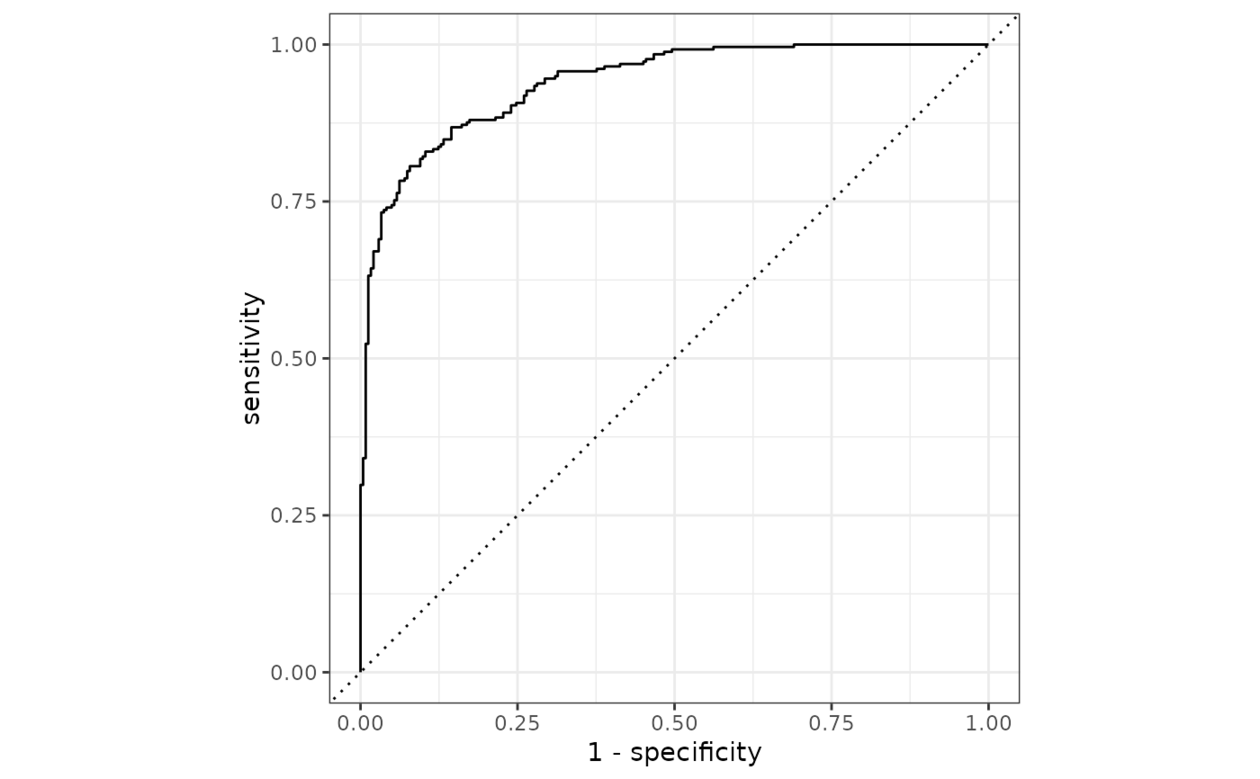roc_curve() 构造完整的 ROC 曲线并返回一个 tibble。有关 ROC 曲线下的面积,请参阅roc_auc()。
用法
roc_curve(data, ...)
# S3 method for data.frame
roc_curve(
data,
truth,
...,
na_rm = TRUE,
event_level = yardstick_event_level(),
case_weights = NULL,
options = list()
)参数
- data
-
包含
truth和...指定的列的data.frame。 - ...
-
一组不带引号的列名称或一个或多个
dplyr选择器函数,用于选择哪些变量包含类概率。如果truth是二进制,则仅应选择 1 列,并且它应对应于event_level的值。否则,列的数量应与truth的因子级别一样多,并且列的顺序应与truth的因子级别相同。 - truth
-
真实类结果的列标识符(即
factor)。这应该是一个不带引号的列名,尽管此参数是通过表达式传递的并且支持quasiquotation(您可以不带引号的列名)。对于_vec()函数,一个factor向量。 - na_rm
-
logical值,指示在计算继续之前是否应剥离NA值。 - event_level
-
单个字符串。
"first"或"second"指定将truth的哪个级别视为"event"。此参数仅适用于estimator = "binary"。默认使用内部帮助程序,通常默认为"first",但是,如果设置了已弃用的全局选项yardstick.event_first,则将使用该帮助程序并发出警告。 - case_weights
-
案例权重的可选列标识符。这应该是一个不带引号的列名称,其计算结果为
data中的数字列。对于_vec()函数,一个数值向量。 - options
-
[deprecated]从尺度 1.0.0 开始不再支持。如果您在此处传递某些内容,它将被忽略并发出警告。
以前,这些选项传递给
pROC::roc()。如果您需要对此的支持,请直接使用 pROC 包。
细节
roc_curve() 计算概率列的每个唯一值(除了无穷大和负无穷大)的灵敏度。
有一个ggplot2::autoplot() 方法可以快速可视化曲线。这适用于二进制和多类输出,也适用于分组数据(即来自重新采样)。请参阅示例。
多级
如果提供了多类 truth 列,则将采用 one-vs-all 方法来计算多条曲线,每个级别一条。在这种情况下,将有一个附加列 .level ,用于标识 one-vs-all 计算中的 "one" 列。
相关级别
在计算二元分类指标时,对于哪个因子级别应自动被视为 "event" 或 "positive" 结果,没有通用约定。在 yardstick 中,默认使用第一级。要更改此设置,请将参数 event_level 更改为 "second" 以将因子的最后一个级别视为感兴趣级别。对于涉及 one-vs-all 比较(例如宏平均)的多类扩展,此选项将被忽略,并且 "one" 级别始终是相关结果。
也可以看看
使用 roc_auc() 计算 ROC 曲线下的面积。
其他曲线指标:gain_curve()、lift_curve()、pr_curve()
例子
# ---------------------------------------------------------------------------
# Two class example
# `truth` is a 2 level factor. The first level is `"Class1"`, which is the
# "event of interest" by default in yardstick. See the Relevant Level
# section above.
data(two_class_example)
# Binary metrics using class probabilities take a factor `truth` column,
# and a single class probability column containing the probabilities of
# the event of interest. Here, since `"Class1"` is the first level of
# `"truth"`, it is the event of interest and we pass in probabilities for it.
roc_curve(two_class_example, truth, Class1)
#> # A tibble: 502 × 3
#> .threshold specificity sensitivity
#> <dbl> <dbl> <dbl>
#> 1 -Inf 0 1
#> 2 1.79e-7 0 1
#> 3 4.50e-6 0.00413 1
#> 4 5.81e-6 0.00826 1
#> 5 5.92e-6 0.0124 1
#> 6 1.22e-5 0.0165 1
#> 7 1.40e-5 0.0207 1
#> 8 1.43e-5 0.0248 1
#> 9 2.38e-5 0.0289 1
#> 10 3.30e-5 0.0331 1
#> # ℹ 492 more rows
# ---------------------------------------------------------------------------
# `autoplot()`
# Visualize the curve using ggplot2 manually
library(ggplot2)
library(dplyr)
roc_curve(two_class_example, truth, Class1) %>%
ggplot(aes(x = 1 - specificity, y = sensitivity)) +
geom_path() +
geom_abline(lty = 3) +
coord_equal() +
theme_bw()
 # Or use autoplot
autoplot(roc_curve(two_class_example, truth, Class1))
# Or use autoplot
autoplot(roc_curve(two_class_example, truth, Class1))
 if (FALSE) {
# Multiclass one-vs-all approach
# One curve per level
hpc_cv %>%
filter(Resample == "Fold01") %>%
roc_curve(obs, VF:L) %>%
autoplot()
# Same as above, but will all of the resamples
hpc_cv %>%
group_by(Resample) %>%
roc_curve(obs, VF:L) %>%
autoplot()
}
if (FALSE) {
# Multiclass one-vs-all approach
# One curve per level
hpc_cv %>%
filter(Resample == "Fold01") %>%
roc_curve(obs, VF:L) %>%
autoplot()
# Same as above, but will all of the resamples
hpc_cv %>%
group_by(Resample) %>%
roc_curve(obs, VF:L) %>%
autoplot()
}
相关用法
- R yardstick roc_aunp 使用先验类别分布,每个类别相对于其他类别的 ROC 曲线下面积
- R yardstick roc_aunu 使用均匀类别分布,每个类别相对于其他类别的 ROC 曲线下面积
- R yardstick roc_auc 接收者操作曲线下面积
- R yardstick rpd 性能与偏差之比
- R yardstick rpiq 绩效与四分位间的比率
- R yardstick rsq R 平方
- R yardstick recall 记起
- R yardstick rmse 均方根误差
- R yardstick rsq_trad R 平方 - 传统
- R yardstick pr_auc 查准率曲线下面积
- R yardstick accuracy 准确性
- R yardstick gain_capture 增益捕获
- R yardstick pr_curve 精确率召回曲线
- R yardstick conf_mat 分类数据的混淆矩阵
- R yardstick mn_log_loss 多项数据的平均对数损失
- R yardstick mae 平均绝对误差
- R yardstick detection_prevalence 检测率
- R yardstick bal_accuracy 平衡的精度
- R yardstick msd 平均符号偏差
- R yardstick mpe 平均百分比误差
- R yardstick iic 相关性理想指数
- R yardstick npv 阴性预测值
- R yardstick sens 灵敏度
- R yardstick poisson_log_loss 泊松数据的平均对数损失
- R yardstick ppv 阳性预测值
注:本文由纯净天空筛选整理自Max Kuhn等大神的英文原创作品 Receiver operator curve。非经特殊声明,原始代码版权归原作者所有,本译文未经允许或授权,请勿转载或复制。
